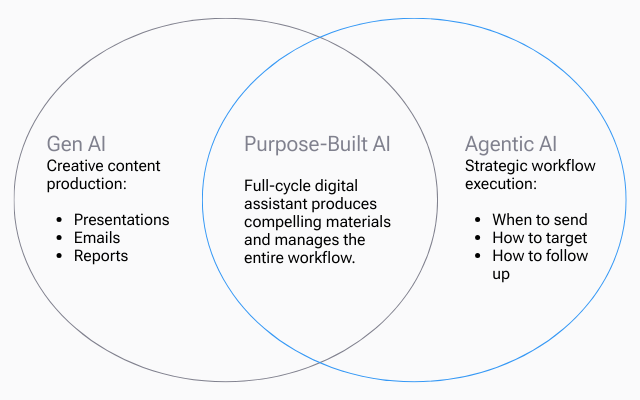Artificial intelligence is no longer on the horizon—it’s already here, reshaping the way investment firms operate. From sourcing and screening to diligence and investor reporting, AI is increasingly embedded in workflows. But for many deal teams, the terminology can feel overwhelming, and it’s not always clear how the pieces fit together.
This post is designed to give you a practical foundation. We’ll start with the language of AI, introduce core building blocks like large language models (LLMs) and AI agents, explain the difference between generative and agentic AI, and finally show how Blueflame AI brings these concepts together in a purpose-built platform for investment professionals.
AI terminology for investment firms
Before diving deeper, let’s establish some common ground. Here are the key terms you’ll hear most often when AI comes up in investment conversations:
Agentic AI
AI systems that can act autonomously to accomplish specific goals, making decisions and taking actions without constant human supervision. These systems can understand objectives, plan steps, and execute tasks.
Example: An AI sales assistant that can independently qualify leads, schedule follow-up meetings, and prepare preliminary proposals based on client requirements.
Artificial Intelligence (AI)
Computer systems that perform tasks requiring human intelligence, like recognizing patterns or making predictions.
Example: An email filter that detects spam.
AI in Private Equity
The application of AI tools and workflows to sourcing, diligence, portfolio monitoring, and fundraising in PE.
Example: Using AI to analyze CIMs and surface red flags faster.
Chatbot
A computer program designed to simulate conversation with human users, especially over the internet. Chatbots can range from simple rule-based systems to sophisticated AI-powered assistants.
Example: Customer service chatbots on websites that answer frequently asked questions, like those used by banks to handle initial customer inquiries before routing to human agents.
Generative AI
Tools that create new content—text, images, or audio.
Example: Drafting a memo from bullet points.
Large Language Model (LLM)
A machine learning model trained on enormous text datasets that can understand context and generate human-like responses.
Example: Summarizing a 200-page diligence report into a concise two-page brief.
Machine Learning (ML)
A subset of AI where algorithms improve at tasks by learning from data.
Example: Fraud detection models that get more accurate as they see more transactions.
Natural Language Processing (NLP)
The branch of AI that enables computers to understand and respond to human language.
Example: Chatbots that answer investor FAQs.
Prompt
The input or instruction given to an AI system that guides its response or output. The quality and specificity of prompts significantly impact the usefulness of AI-generated results.
Example: "Draft a follow-up email to a prospect who expressed interest in our enterprise solution but has concerns about implementation timeline" is a prompt that guides the AI to create specific, relevant content.
Prompt Engineering
The practice of crafting precise instructions to guide AI output.
Semantic Search
A search method that understands the meaning and context of words, not just exact matches. It uses embeddings to find results that are conceptually related to a query.
Example: Searching “growth-stage fintech firms” returns companies described as “emerging digital banks” or “payment platforms,” even if those exact words aren’t used.
Use Case
A specific scenario or application where AI can be deployed to solve a business problem or improve a process. Identifying clear use cases helps in effectively implementing AI solutions.
Example: Using AI to analyze call transcripts from sales conversations to identify patterns in successful deals and provide coaching recommendations to the sales team.
Before we compare different types of AI, it helps to understand the underlying building blocks that make modern systems work. Think of these as the foundation: the engines that generate language, and the operators that can carry out tasks on your behalf. Together, they form the backbone of today’s AI applications in investment workflows.
What is an LLM in investment management?
Large Language Models (LLMs) are the engines powering most modern AI tools. Trained on billions of words, they predict the next word in a sentence based on context. This deceptively simple mechanism enables them to summarize reports, draft communications, and answer complex questions.
For deal teams, this means:
- Summarizing CIMs and diligence reports in minutes.
- Drafting outreach emails and investor updates.
- Answering queries using firm-specific data.
But LLMs on their own don’t know your systems, workflows, or compliance requirements. They need to be embedded in a secure, purpose-built platform that governs access to data, enforces auditability, and connects outputs back to investment processes. That’s where AI agents and purpose-built AI come in.
What are AI agents and why do they matter for PE and investment firms?
If LLMs are the engines of AI, then AI agents are the operators. Agents use models like LLMs to carry out defined tasks—and, increasingly, entire workflows. Rather than just producing an answer, an agent can decide which steps to take, interact with data and tools, and deliver a result that’s closer to how an analyst or associate would work.
What can AI agents do?
In practice, agents can:
- Observe: Monitor systems, data, or documents for relevant information.
- Plan: Break a larger goal into steps, sequencing tasks logically.
- Act: Execute those steps by pulling data, drafting outputs, or triggering workflows in CRMs, data rooms, or email platforms.
- Learn: Improve over time by storing memory, refining responses, and incorporating feedback.
What are the types of AI agents?
At a high level, agents tend to fall into two categories:
- Task-oriented agents handle well-defined, repeatable work—similar to junior analysts following standard operating procedures. PE workflow example: Reviewing CIMs for add-on opportunities in a portfolio company’s sector.
- Executive function agents represent the next stage of maturity. More like principals or VPs, they can prioritize tasks, delegate to other agents, adapt to new information, and orchestrate broader workflows. PE workflow example: coordinating deal sourcing outreach across bankers and intermediaries.
Together, these types show the evolution from today’s narrow task execution toward future agents that can coordinate end-to-end processes with greater autonomy.
For investment firms, agents are important because they represent the move from AI as a tool for drafting outputs to AI as a teammate that can execute work—with humans still in the loop for strategy and judgment.
Generative AI vs. Agentic AI in investment management
With LLMs and agents in mind, let’s clarify two terms that often get conflated:
- Generative AI is creative. It produces text, images, and ideas. It’s reactive by nature—when you ask for 10 email templates, it will generate them. But it won’t know which template to send, when, or to whom.
- Agentic AI is operational. It doesn’t just generate—it acts. An agentic system can analyze your CRM, prioritize leads, draft personalized messages, schedule follow-ups, and adapt based on results.
Together, generative and agentic AI form a powerful combination. Generative AI creates the content; agentic AI orchestrates the workflow. For PE firms, generative AI might draft LP updates or diligence notes, while agentic AI ensures those drafts are populated with the right deal data and routed through compliance.
What is Blueflame AI?
So far, we’ve talked about the building blocks of AI in investment management: LLMs as the engines, agents as the operators, and the roles of generative and agentic AI. But the real impact comes when these pieces are combined in a platform that’s purpose-built for investment work. That’s exactly what Blueflame AI delivers.
Blueflame is an AI platform designed specifically for the workflows of private equity, private credit, investment banks, M&A advisors, endowments, and real estate firms. The platform unifies internal firm knowledge, third-party systems, and public data into one secure, compliant environment—and applies both generative and agentic AI to make that information actionable.
How it works:
- Generative AI powers the creation of high-quality outputs: memos, summaries, outreach drafts, and diligence notes.
- Agentic AI ensures those outputs are part of a broader workflow: pulling the right data, applying firm context, and orchestrating tasks across CRMs, data rooms, and collaboration tools.
- Together, they act as a full-cycle digital assistant—not just answering questions, but actually helping teams source, evaluate, and execute more effectively.
By bringing these capabilities into one platform, Blueflame addresses the most pressing pain points in investment management, turning turns AI from an interesting experiment into a trusted teammate—one that accelerates decisions, improves output quality, and ensures every step of the process is rooted in secure, compliant, firm-specific data.

Turning AI into a trusted virtual teammate
AI can feel like a maze of jargon and hype, but the path forward for investment firms is clear: understand the building blocks, see how generative and agentic AI complement each other, and explore the role of agents in reshaping workflows.
The real unlock comes not from experimenting with generic tools, but from adopting purpose-built AI that ties it all together. Blueflame AI delivers that: a secure, domain-specific platform that combines the creativity of generative AI, the orchestration of agentic AI, and the execution power of AI agents.
The result? Faster, smarter decisions—and more time spent on the high-value work that drives returns.

.avif)
.png)
.png)
